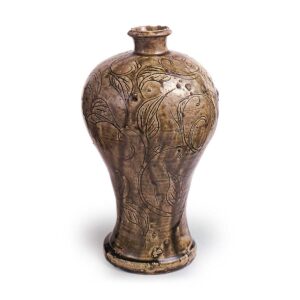
Excavated from Haibara Kiln, Haramachi, Seto City, Aichi Prefecture, Japan
14th century
Height 30.5cm, mouth diameter 5.5cm, body diameter 17.6cm, bottom diameter 11.8cm
The Haibara Kiln was active from the end of the Kamakura period to the Nanbokucho period (1392-1333), the peak of the Koseto period, and is famous for producing a number of excellent products. This piece is made of water-ground molding, with a slightly bulging shoulder and a large overhang at the bottom. The design is characterized by the fine lines of the nail carving style characteristic of this period, with a design of leaves and trees filling the entire surface. The iron glaze is well melted, but the ash feldspar content is high, resulting in a blue-black candy glaze.



